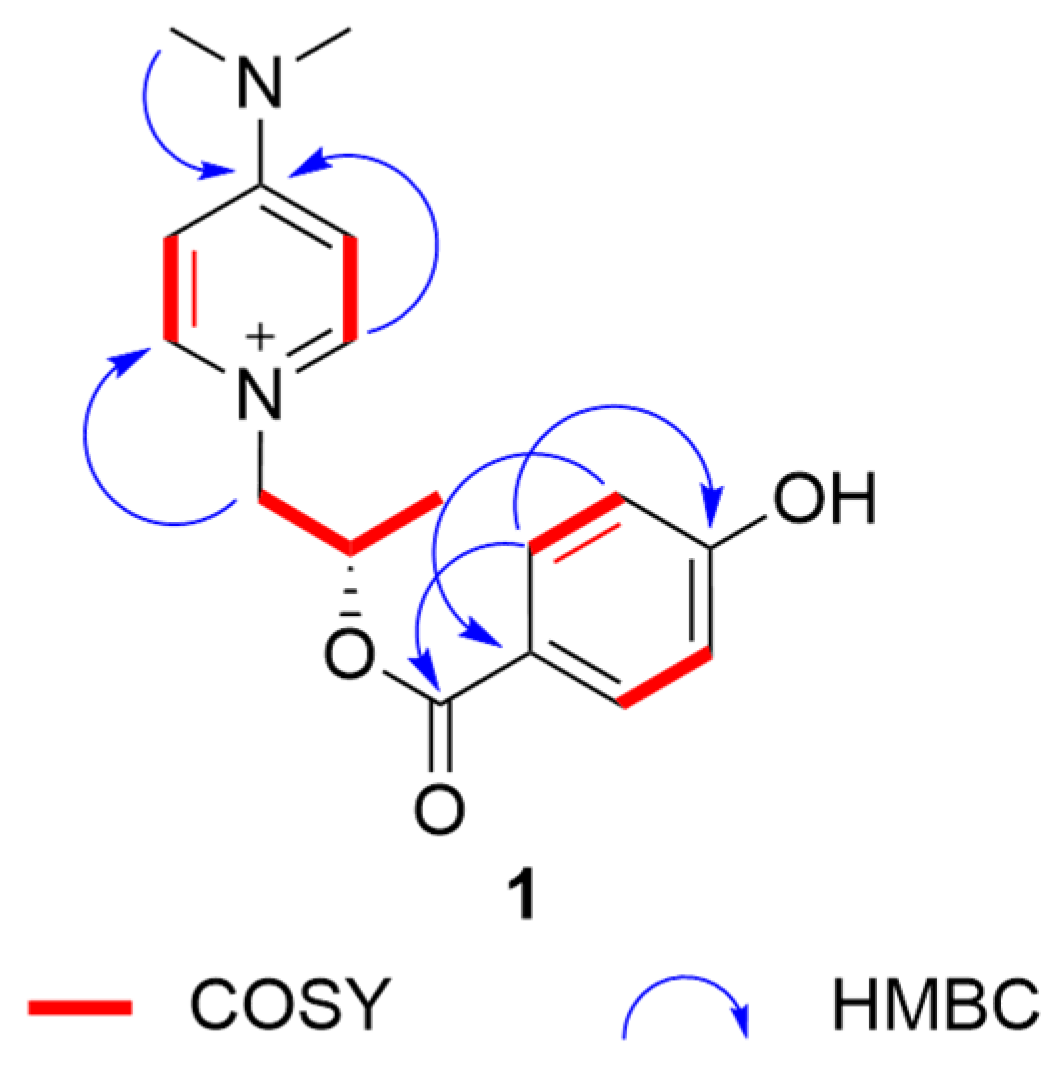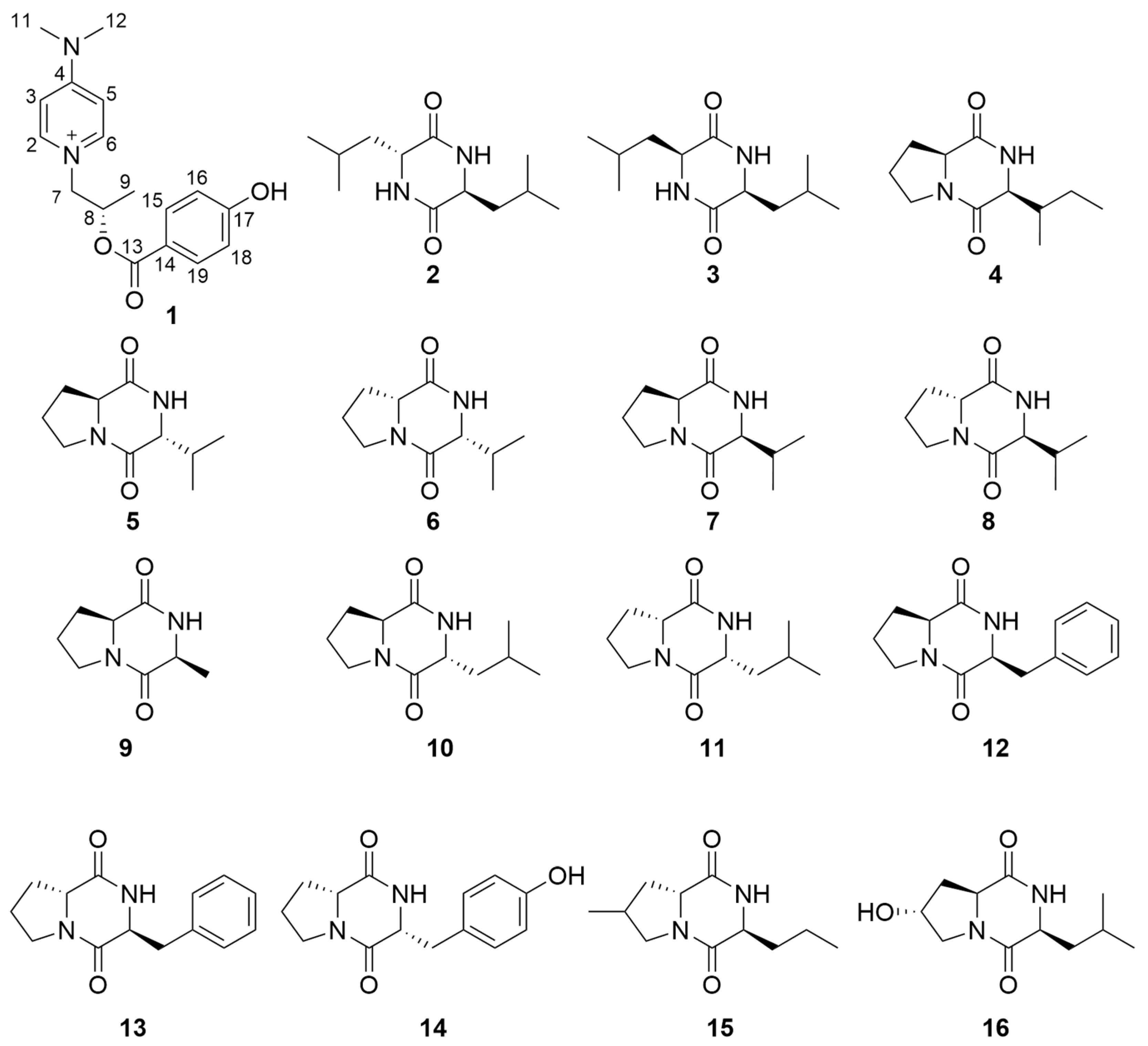New Pyridinium Compound from Marine Sediment-Derived Bacterium Bacillus licheniformis S-1
Abstract
1. Introduction
2. Results
3. Materials and Methods
3.1. General Experimental Procedure
3.2. Bacterial Material
3.3. Fermentation, Extraction and Isolation
3.4. Antimicrobial Activity Assays
4. Conclusions and Discussions
Supplementary Materials
Author Contributions
Funding
Institutional Review Board Statement
Informed Consent Statement
Data Availability Statement
Conflicts of Interest
References
- Chukwudulue, U.M.; Barger, N.; Dubovis, M.; Luzzatto Knaan, T. Natural products and pharmacological properties of symbiotic bacillota (firmicutes) of marine macroalgae. Mar. Drugs 2023, 21, 569. [Google Scholar] [CrossRef] [PubMed]
- Lv, F.; Zeng, Y.B. Novel bioactive natural products from marine-derived Penicillium fungi: A review (2021–2023). Mar. Drugs 2024, 22, 191. [Google Scholar] [CrossRef]
- Yang, G.; Lin, M.; Kaliaperumal, K.; Lu, Y.; Qi, X.; Jiang, X.; Xu, X.; Gao, C.; Liu, Y.; Luo, X. Recent advances in anti-inflammatory compounds from marine microorganisms. Mar. Drugs 2024, 22, 424. [Google Scholar] [CrossRef]
- Pathak, A.P.; Deshmukh, K.B. Alkaline protease production, extraction and characterization from alkaliphilic Bacillus licheniformis KBDL4: A Lonar soda lake isolate. Indian J. Exp. Biol. 2012, 50, 569–576. [Google Scholar] [PubMed]
- Liu, J.; Yang, C.; Chi, Y.; Wu, D.; Dai, X.; Zhang, X.; Igarashi, Y.; Luo, F. Algicidal characterization and mechanism of Bacillus licheniformis Sp34 against Microcystis aeruginosa in Dianchi Lake. J. Basic Microbiol. 2019, 59, 1112–1124. [Google Scholar] [CrossRef]
- Bernardeau, M.; Lehtinen, M.J.; Forssten, S.D.; Nurminen, P. Importance of the gastrointestinal life cycle of Bacillus for probiotic functionality. J. Food Sci. Technol. Mysore 2017, 54, 2570–2584. [Google Scholar] [CrossRef]
- Chen, Y.Y.; Yu, Q.Q. Effects of Bacillus licheniformis granules, live combined with conventional treatment on children with rotavirus enteritis. Med. J. Chin. People’s Health 2024, 36, 51–53. [Google Scholar] [CrossRef]
- Devi, P.; Wahidullah, S.; Rodrigues, C.; Souza, L.D. The sponge-associated bacterium Bacillus licheniformis SAB1: A Source of antimicrobial compounds. Mar. Drugs 2010, 8, 1203–1212. [Google Scholar] [CrossRef]
- Batrakov, S.G.; Rodionova, T.A.; Esipov, S.E.; Polyakov, N.B.; Sheichenko, V.I.; Shekhovtsova, N.V.; Lukin, S.M.; Panikov, N.S.; Nikolaev, Y.A. A novel lipopeptide, an inhibitor of bacterial adhesion, from the thermophilic and halotolerant subsurface Bacillus licheniformis strain 603. Biochim. Biophys. Acta 2003, 1634, 107–115. [Google Scholar] [CrossRef]
- Jeong, M.-H.; Lee, Y.-S.; Cho, J.-Y.; Ahn, Y.-S.; Moon, J.-H.; Hyun, H.-N.; Cha, G.-S.; Kim, K.-Y. Isolation and characterization of metabolites from Bacillus licheniformis MH48 with antifungal activity against plant pathogens. Microb. Pathog. 2017, 110, 645–653. [Google Scholar] [CrossRef] [PubMed]
- Prakash, A.A.; Prabhu, N.S.; Rajasekar, A.; Parthipan, P.; AlSalhi, M.S.; Devanesan, S.; Govarthanan, M. Bio-electrokinetic remediation of crude oil contaminated soil enhanced by bacterial biosurfactant. J. Hazard. Mater. 2021, 405, 124061. [Google Scholar] [CrossRef]
- Mondal, H.; Chandrasekaran, N.; Mukherjee, A.; Thomas, J. Antibacterial activity of Bacillus licheniformis isolated from marine sediments and its effect in treating Aeromonas hydrophila infection in freshwater prawn, Macrobrachium rosenbergii. Aquacult. Int. 2023, 31, 3071–3093. [Google Scholar] [CrossRef]
- Phelan, R.; O’halloran, J.; Kennedy, J.; Morrissey, J.; Dobson, A.; O’gara, F.; Barbosa, T. Diversity and bioactive potential of endospore-forming bacteria cultured from the marine sponge Haliclona simulans. J. Appl. Microbiol. 2012, 112, 65–78. [Google Scholar] [CrossRef]
- Bai, M.; Zheng, C.-J.; Wu, S.-Y.; Chen, G.-Y.; Song, X.-P.; Han, C.-R. Chemical constituents from Scutellaria hainanensis C. Y. Wu. Biochem. Syst. Ecol. 2019, 82, 1–12. [Google Scholar] [CrossRef]
- Lu, X.; Shen, Y.; Zhu, Y.; Xu, Q.; Liu, X.; Ni, K.; Cao, X.; Zhang, W.; Jiao, B. Diketopiperazine constituents of marine Bacillus subtilis. Chem. Nat. Compd. 2009, 45, 290–292. [Google Scholar] [CrossRef]
- Chen, R.Q.; Luo, X.C.; Lin, H.W.; Jiao, W.H. Secondary metabolites of a marine sponge associated Streptomyces parvulus 162432. Chin. Herb. Med. 2023, 54, 4104–4110. [Google Scholar]
- Yang, Z.-D.; Li, Z.-J.; Zhao, J.-W.; Sun, J.-H.; Yang, L.-J.; Shu, Z.-M. Secondary metabolites and PI3K inhibitory activity of Colletotrichum gloeosporioides, a fungal endophyte of Uncaria rhynchophylla. Curr. Microbiol. 2019, 76, 904–908. [Google Scholar] [CrossRef] [PubMed]
- Bhattacharya, D.; Lai, T.K.; Saha, A.; Selvin, J.; Mukherjee, J. Structural elucidation and antimicrobial activity of a diketopiperazine isolated from a Bacillus sp. associated with the marine sponge Spongia officinalis. Nat. Prod. Res. 2021, 35, 2315–2323. [Google Scholar] [CrossRef]
- Fdhila, F.; Vázquez, V.; Sánchez, J.L.; Riguera, R. DD-Diketopiperazines: Antibiotics active against Vibrio anguillarum isolated from marine bacteria associated with cultures of Pecten maximus. J. Nat. Prod. 2003, 66, 1299–1301. [Google Scholar] [CrossRef] [PubMed]
- Adamczeski, M.; Reed, A.R.; Crews, P. New and known diketopiperazines from the caribbean sponge, calyx cf. podatypa. J. Nat. Prod. Lloydia 1995, 58, 201–208. [Google Scholar] [CrossRef]
- Danh, C.Đ.; Nam, V.V.; Hương, Đ.T.M.; Quyên, V.T.; Murphy, B.T.; Thạch, T.Đ.; Minh, C.V.; Cường, P.V. Nghiên cứu một số hợp chất thứ cấp từ chủng xạ khuẩn Streptomyces sp.(G065). Vietnam. J. Chem. 2017, 55, 19. [Google Scholar]
- Fu, H.C.; Zhong, H.M. Studies on the chemical constituents of marine bacterium Pseudomonas sp. J. Qingdao Univ. Sci. Technol. 2009, 30, 31–33. [Google Scholar]
- Lv, H.N.; Chen, H.; Qu, J.; Li, Y.; Ma, S.G.; Liu, Y.B. Study on secondary metabolites of endophytic fungi Trichoderma harzianum. Mod. Chin. Med. 2015, 17, 427–430. [Google Scholar] [CrossRef]
- Sun, Y.-X.; Zhou, Z.-F.; Guan, X.-K.; Deng, J.-S.; Li, G.-H. Metabolites from a global regulator engineered strain of Pseudomonas lurida and their inducement of trap formation in Arthrobotrys oligospora. Chem. Biol. Technol. Agric. 2024, 11, 1–13. [Google Scholar] [CrossRef]
- Kwon, O.S.; Park, S.H.; Yun, B.-S.; Pyun, Y.R.; Kim, C.-J. Cyclo (D-Pro-L-Val), a specific ß-glucosidase inhibitor produced by Aspergillus sp F70609. J. Antibiot. 2001, 54, 179–181. [Google Scholar] [CrossRef]
- Zeng, X.R.; Jiao, W.H.; Tang, J.S.; Gao, H.; Hong, K.; Jia, L.I.; Yao, X.S. Secondary metabolites from marine actinomycete Streptomyces sp.(No. 30701). Chin. J. Med. Chem. 2010, 20, 298–303. [Google Scholar] [CrossRef]
- Lin, Z.H.; Ding, W.P.; Li, Y.Q.; Chen, R.W.; Gao, Y.L.; Yin, H. Chemical constituents of marine derived actinomycete Demequina litorisediminis SCSIO 53428. Cent. South Pharm. 2020, 18, 213–217. [Google Scholar]
- Yang, B.; Dong, J.; Zhou, X.; Yang, X.; Lee, K.J.; Wang, L.; Zhang, S.; Liu, Y. Proline-containing dipeptides from a marine sponge of a Callyspongia species. Helv. Chim. Acta 2009, 92, 1112–1117. [Google Scholar] [CrossRef]
- Hwang, J.; Jang, H.-J.; Kim, J.; Park, C.; Kim, Y.; Lim, C.-H.; Lee, S.; Rho, M.-C. Lactococcus lactis KR-050L inhibit IL-6/STAT3 activation. J. Appl. Microbiol. 2017, 122, 1412–1422. [Google Scholar] [CrossRef]
- Li, Y.; Tang, J.; Gao, H.; Lin, H.; Hong, K.; Yao, X. Study of anti-MSRA bioactive constituents from a marine actinomycetes Micromonospora sp. (No. 69). Chin. J. Mar. Drugs 2010, 29, 16–21. [Google Scholar] [CrossRef]
- Wang, G.; Dai, S.; Chen, M.; Wu, H.; Xie, L.; Luo, X.; Li, X. Two diketopiperazine cyclo (pro-phe) isomers from marine bacteria Bacillus subtilis sp. 13-2. Chem. Nat. Compd. 2010, 46, 583–585. [Google Scholar] [CrossRef]
- Jayatilake, G.S.; Thornton, M.P.; Leonard, A.C.; Grimwade, J.E.; Baker, B.J. Metabolites from an Antarctic sponge-associated bacterium, Pseudomonas aeruginosa. J. Nat. Prod. 1996, 59, 293–296. [Google Scholar] [CrossRef]
- QV, C.L.; Yang, X.; Zhang, S.M.; Xie, Z.P.; Jin, H.Z. Study of diketopiperazines from the marine-derived Streptomyces sp. 223. Chin. J. Mar. Drugs 2015, 34, 23–28. [Google Scholar] [CrossRef]
- Shi, T.; Li, X.Q.; Wang, Z.M.; Zheng, L.; Yu, Y.Y.; Dai, J.J.; Shi, D.Y. Bioactivity-guided screening of antimicrobial secondary metabolites from antarctic cultivable fungus Acrostalagmus luteoalbus CH-6 combined with molecular networking. Mar. Drugs 2022, 20, 334. [Google Scholar] [CrossRef] [PubMed]


| δC, multi. a | δH (J/Hz) a | |
|---|---|---|
| 2, 6 | 143.8, CH | 8.09 (d, 7.8) |
| 3, 5 | 108.4, CH | 6.96 (d, 7.8) |
| 4 | 158.1, C | |
| 7 | 65.0, CH2 | 4.23, dd (13.7, 2.9) |
| 3.91–3.87, m | ||
| 8 | 67.5, CH | 4.06–4.00, m |
| 9 | 20.6, CH3 | 1.22 (d, 6.3) |
| 11, 12 | 40.2, CH3 | 3.24, s |
| 13 | 175.6, C | |
| 14 | 129.8, C | |
| 15, 19 | 132.3, CH | 7.82 (d, 8.7) |
| 16, 18 | 115.3, CH | 6.72 (d, 8.6) |
| 17 | 161.0, C |
Disclaimer/Publisher’s Note: The statements, opinions and data contained in all publications are solely those of the individual author(s) and contributor(s) and not of MDPI and/or the editor(s). MDPI and/or the editor(s) disclaim responsibility for any injury to people or property resulting from any ideas, methods, instructions or products referred to in the content. |
© 2024 by the authors. Licensee MDPI, Basel, Switzerland. This article is an open access article distributed under the terms and conditions of the Creative Commons Attribution (CC BY) license (https://creativecommons.org/licenses/by/4.0/).
Share and Cite
Wang, H.; Wang, Y.; Li, Y.; Wang, G.; Shi, T.; Wang, B. New Pyridinium Compound from Marine Sediment-Derived Bacterium Bacillus licheniformis S-1. Molecules 2025, 30, 7. https://doi.org/10.3390/molecules30010007
Wang H, Wang Y, Li Y, Wang G, Shi T, Wang B. New Pyridinium Compound from Marine Sediment-Derived Bacterium Bacillus licheniformis S-1. Molecules. 2025; 30(1):7. https://doi.org/10.3390/molecules30010007
Chicago/Turabian StyleWang, Han, Yifei Wang, Yanjing Li, Guilin Wang, Ting Shi, and Bo Wang. 2025. "New Pyridinium Compound from Marine Sediment-Derived Bacterium Bacillus licheniformis S-1" Molecules 30, no. 1: 7. https://doi.org/10.3390/molecules30010007
APA StyleWang, H., Wang, Y., Li, Y., Wang, G., Shi, T., & Wang, B. (2025). New Pyridinium Compound from Marine Sediment-Derived Bacterium Bacillus licheniformis S-1. Molecules, 30(1), 7. https://doi.org/10.3390/molecules30010007





